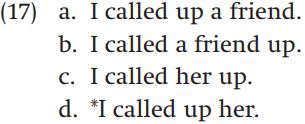
Phrasal verbs and verbs with separable prefixes
 المؤلف:
Rochelle Lieber
المؤلف:
Rochelle Lieber
 المصدر:
Introducing Morphology
المصدر:
Introducing Morphology
 الجزء والصفحة:
151-8
الجزء والصفحة:
151-8
 25-1-2022
25-1-2022
 1976
1976
Phrasal verbs and verbs with separable prefixes
Also inhabiting the borderland between morphology and syntax are phrasal verbs in English and verbs with separable prefixes in German and Dutch. Phrasal verbs are verbs like those in (16) that consist of a verb and a preposition or particle:

Frequently, phrasal verbs have idiomatic meanings, as the glosses in (16) show, and in that sense they are like words. In terms of structure, the combination of verb and particle/preposition might seem like another sort of compound in English. Remember, however, that one of the criteria for distinguishing a compound from a phrase in English was that the two elements making up compounds could not be separated from one another. We cannot take a compound like dog bed and insert a word to modify bed (for example, *dog comfortable bed). In contrast, however, the two parts of the phrasal verb can be, and sometimes must be, separated:

When the object of the verb is a full noun phrase, the particle can precede or follow it. In the former case it is adjacent to its verb, but in the latter case it is separated from the verb. And when the object is a pronoun, the particle must be separated from the verb. So do we consider phrasal verbs to be a matter of study for morphologists, or do we leave them to syntacticians? There is no set answer to this question.
A similar issue arises with what are called separable prefix verbs in Dutch. Consider the examples in (18):

Like phrasal verbs in English, separable prefix verbs in Dutch often have idiomatic meanings. For example, opbellen, like English ‘call up’ means ‘to telephone’. Each separable prefix verb in Dutch consists of a verb preceded by a word of another category; in (18), op is a preposition, schoon is an adjective, and piano is a noun. These words therefore look a bit like prefixed words or perhaps compounds. But there’s a difference.
To understand the examples in (18) you need to know that Dutch exhibits different word orders in main clauses than in subordinate clauses. In main clauses the main verb is always the second constituent in the clause. If the subject is first, the main verb comes right after it. But in subordinate clauses, the main verb always comes last. The examples in (18) show that when the verbs opbellen ‘call up’, schoonmaken ‘make clean’, and pianospelen ‘play piano’ occur in a subordinate clause, those complex verbs come at the end of the clause. The first elements op, schoon, and piano occur attached to the verb, almost like prefixes. However, when the verb is used in a main clause, the verb itself occurs after the subject, but its first element appears separated from it at the end of the sentence. So unlike normal prefixes, these elements sometimes are not attached to the verbs with which they normally form a unit. Are separable prefix verbs a matter for morphologists or for syntacticians? Again, there is no easy answer to this question, as they lie on the border between the two.
 الاكثر قراءة في Morphology
الاكثر قراءة في Morphology
 اخر الاخبار
اخر الاخبار
اخبار العتبة العباسية المقدسة


